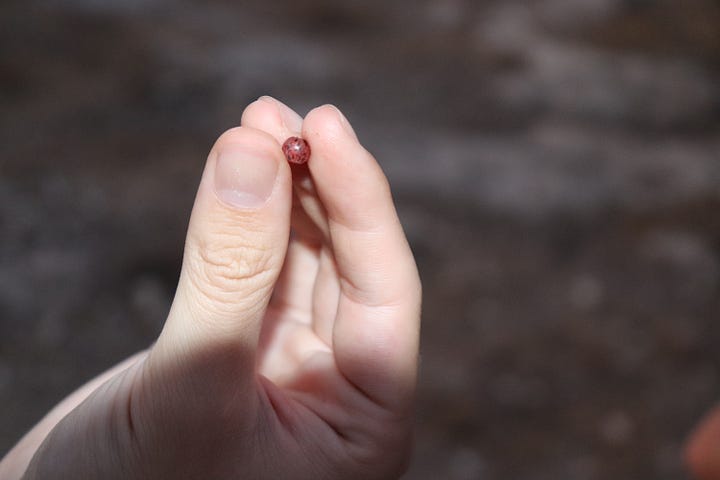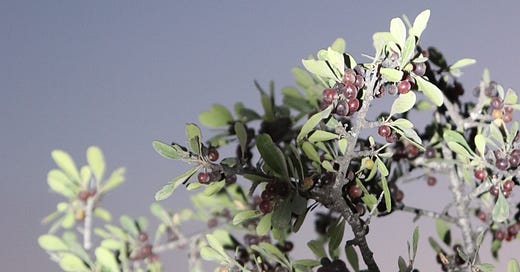Buckthorn Berries, Anyone?
Delicious berries are now in season all over Natural Israel.
Foraging in the Fall
Dear Healthy Jew,
When I tell people about Foraging Walks in Natural Israel, if it’s anytime after June, they often reply that they’re excited to join next spring because now there’s surely nothing left.
What plant can possibly survive the hot and dry Israeli summer? Don’t you see everything is all brown?
Actually, one of the best foraging seasons is right now, in late summer and early fall. Soon the rains will invite a new year of life, but now we’re picking last year’s delicious fruits.
Because of this tragic crisis, now isn’t the best time to traipse up hills and across valleys. But some of Natural Israel’s best late-summer presents await you in many local parks and at the edges of populated areas.
Of course, never forage without guidance from a qualified professional. All information here is for educational purposes only!
Buckthorn Berries


Mediterranean buckthorn (Rhamnus lycioides) is one of Natural Israel’s hardiest shrubs, and grows pretty much everywhere in the country. Not for naught is it called in Hebrew ashchar eretz yisraeli (Israeli Ashchar). (It also grows throughout the Mediterranean basin and parts of Europe.)
In late summer, these bushes (which sometimes grow into small trees) fill their thorny branches with many thousands of tiny, striped berries. It’s not uncommon to find scores of buckthorn bushes on a single hill. Picture the whole country’s harvest, and you’ve got billions of berries
Are buckthorn berries edible? It depends who you ask.
Wikipedia reports that they are “purgative, very bitter and in large quantities is toxic to humans,” adding that “the fruit can cause death in mammals, but is consumed by ants and birds.” Sounds scary.
But experienced foragers know that buckthorn berries are actually edible, sweet, and extremely nutritious - but caution to never eat more than one fistful a day, and don’t eat the pits.
I’ve shared buckthorn with hundreds of people on foraging walks, and it’s always one of the highlights of the experience. I suggest that kids eat around 10-15 berries, and adults 25-30. And if you have any stomach problems, better to taste just one or two.
Even eating more than that berries is probably not lethal. (But please don’t try.) In the days before antibiotics, they were traditionally used as a medicine to purge the digestive system (perhaps a natural version of the strong laxatives used before colonoscopies). If you eat too many, you’ll end up with a stomach cramps and diarrhea. (I learned the hard way.) Not fun, but not deadly.
On a foraging walk just several weeks ago, explaining how to eat buckthorn properly.
If buckthorn sounds scary (although it really isn’t!), check out this post for a far more benign berry:
Thank you for reading Healthy Jew.
Here are 2 great paths to continue the journey:
Also check out this intro and index to explore hundreds of posts about our 3 Healthy Jew topics: Wellness with Wisdom, Land of Life (Israel), and Sensible Spirituality.
Finally, always feel free to reach out here with any comments, questions, or complaints:
I look forward to hearing from you!
Be well,
Rabbi Shmuel Chaim Naiman









Yes, I won’t taste them without expert local advice.
We also have buckthorn here in Idaho in the northwestern U.S.A. It is arid in the southern part of this state, where only a few species of trees are native. A quick search online tells me we have multiple native genera in the family Rhamnaceae. Your buckthorn photo looks like plants I see here. I am glad to know more about them. I look forward to this series!